Virtual Events – Good, Better, What’s Next?
Angie Kellen, Director, Client Services, Open Sky Communications
Back in June, I wrote about the pros and cons of  Physical versus Virtual Events and some of the ways that companies can leverage online platforms to better engage with their audiences. Today, I’m taking this one step further. If you’re in the technology field, you’ve likely had the opportunity to attend several virtual events over the past six months. From the four that I have attended, my experiences have varied from just OK to actually being productive.
Physical versus Virtual Events and some of the ways that companies can leverage online platforms to better engage with their audiences. Today, I’m taking this one step further. If you’re in the technology field, you’ve likely had the opportunity to attend several virtual events over the past six months. From the four that I have attended, my experiences have varied from just OK to actually being productive.
Keeping in mind that many of these event organizers had to learn on-the-fly and make quick decisions on virtual platforms due to COVID-19, I am reluctant to be too critical. One aspect of a virtual event that is just inherent to the virtual platform is the challenge of connecting with the media. All good PR people work hard to connect the media with their clients for interviews. The virtual platform allows the flexibility to arrange briefings with editors via phone, zoom, email, etc. However, since the media aren’t forced to be in a physical place for a week, there isn’t a captive audience to line up a large number of meetings in a short period with key executives. This can result in fewer meetings for clients. At the same time, without the editors having to jam meetings in between the event program, lunch breaks, etc., they can better focus on each meeting so they become more comprehensive and potentially of higher impact.
Beyond that aspect, there were some glaring issues with the virtual events I participated in. By pointing them out, my intention is not to be critical, but to illustrate how these platforms have evolved and what worked even when using the same virtual platform provider. I won’t go through all the events that I have attended but will use two to illustrate which one was a ‘Good’ event and which was ‘Better’ and why. Also, I will touch on what is on the horizon for virtual event platforms.
Good
For those in the semiconductor industry, the big event of the year in the United States is in July. I supported clients and have personally attended this event for 19 years. This year, SEMICON West celebrated its 50th year and had to move to a virtual platform. After so many years hosting a physical trade show, I am sure the work and time invested to decide on a virtual platform was tremendous. Some of the considerations when moving from a physical to a virtual environment are around the fact that the virtual format has pros and cons that work against each other.
- Pros – provides more flexibility to see material on demand at a later time
- Cons – because the virtual format doesn’t force you to be in one place for a defined period of time, it is easy to be pulled away from the show to do regular work and end up not spending much time at the show itself.
With little lead time, SEMI had to find a platform that allowed for the best format to keep attendees engaged and provide relevant information and materials. With a July event date, SEMI became early adopters of the virtual platform and didn’t have many events to use as a model. SEMI chose to work with 6Connex, which is a leading provider of virtual environments.
SEMICON West included live keynotes and panel discussions along with speaker videos with technical slide presentations that ran throughout the event. The environment was modeled after an actual tradeshow, where you walk into a lobby, go to an auditorium to hear speaker presentations and visit the exhibitor section to check out the various company booths. To add a networking and live communication element, there were lounges and chat rooms set up to help continue or start conversations. Also, attendees could reach out to companies at their booth using a live chat feature. If you didn’t want to talk to anyone, the platform allowed the attendee to download tons of information and videos provided by the exhibiting companies. To help the engagement, there was a scavenger hunt-type challenge that attendees could participate in to win daily prizes. In the end, everyone’s backs and feet were saved from the pain from miles of walking and standing on the hard tradeshow floor. But did the exhibiting companies and speakers accomplish their goals? What could be improved for the next event provided that we are still in COVID times?
Blending my feedback with that of others that I had spoken to, here are a few pros and cons with the virtual platform SEMI chose:
- Pros – it was possible to search for exhibitors by company name, and that was helpful if you had someone specific in mind to look for.
- Pros – if you had an exhibitor pass only, you were not able to access the SmartTech pavilion talks during the official week of the show, but they were still accessible after the show officially concluded.
- Cons – searching for exhibitors using the ‘search by product category’ listing was difficult as not all of the categories were visible. The tool bar covered who knows how many categories.
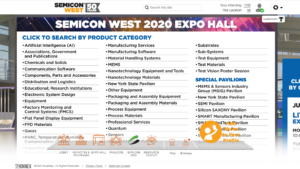
- Cons – in the case of one client exhibiting at the show, there were issues with ‘press kit’ materials and some competitor info was included by SEMI in its list of materials. Not good.
- Cons – it was hard to visualize what each exhibitor did since the booth layout was basically the same for each company. You had to go through the booth description and material for several minutes in some cases.
- Cons – at times I would skip over a company booth after five seconds and then receive a note from a booth rep of that company five minutes later. The chats were not clearly labeled and I would forget which company was reaching out to me as I had already moved on to another booth.
In the end, SEMICON West meets the Good category. For those that I received reactions from, the event didn’t hurt them to be there, but it didn’t exactly help them to meet their tradeshow and new business goals. Was it that the exhibitors had over-inflated expectations for their first time in a virtual environment? Or is this a great case for virtual event growing pains? I think the latter is true.
Better
Display Week 2020 by the Society for Information Display (SID) in August also had to quickly make its event virtual. Display Week is the premiere event for the ecosystem companies around displays and display technologies. SID also chose to work with 6Connex for its virtual event platform. However, it appears that they chose a different package as the look and feel is a bit different and more user friendly than what SEMI chose for its SEMICON West event. Let’s look at the lobbies of each:
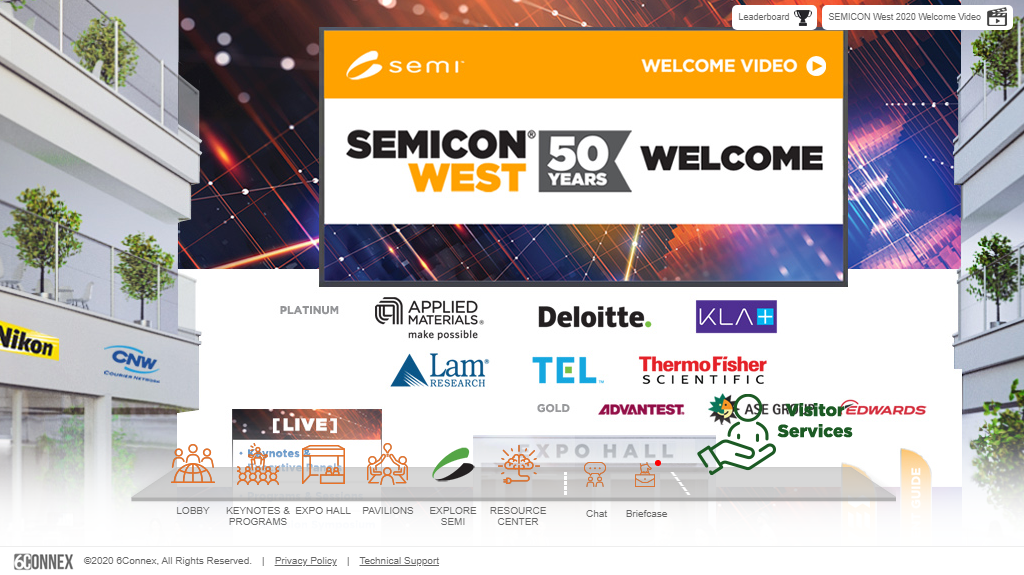
SEMICON West’s virtual lobby looks a bit crammed with logos, etc.
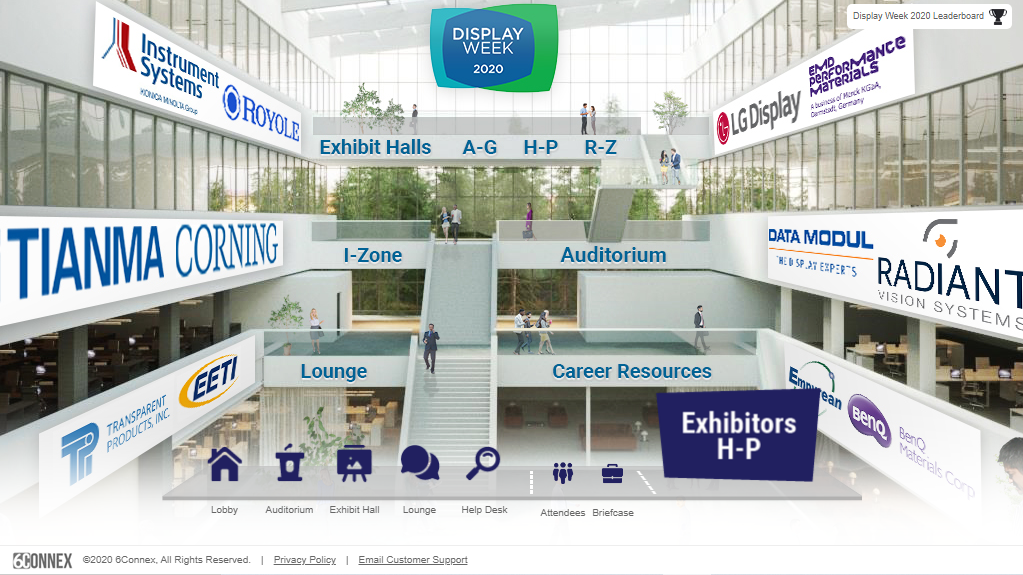 Display Week’s virtual lobby is clean and easy to navigate.
Display Week’s virtual lobby is clean and easy to navigate.
Is this a result of a different virtual event package choice or taking advantage of a learning curve from SEMI’s event? I don’t know the answer to that but let’s look at a few more areas where I thought the Display Week event solved some of the issues SEMICON West had with regard to searching for exhibitors.
As noted earlier, for SEMICON West, searching for exhibitors using the ‘search by product category’ listing was difficult as not all of the categories were visible. In the image below, Display Week improved on this by providing a directory of exhibitors at the top of each exhibitor page. Also, the exhibitors were arranged by alphabetical groups, making it quick to get to the company of your choice.
For the virtual SEMICON West, it was hard to visualize what each exhibitor did since the booth layout was basically the same for each company. Also included below is a sample of Display Week’s company pop-up that appears when you scroll your cursor over the company name (see I-PEX for example).
Quickly, you know what they do and can make the decision to explore the booth, chat with a sales person or move on to another booth. 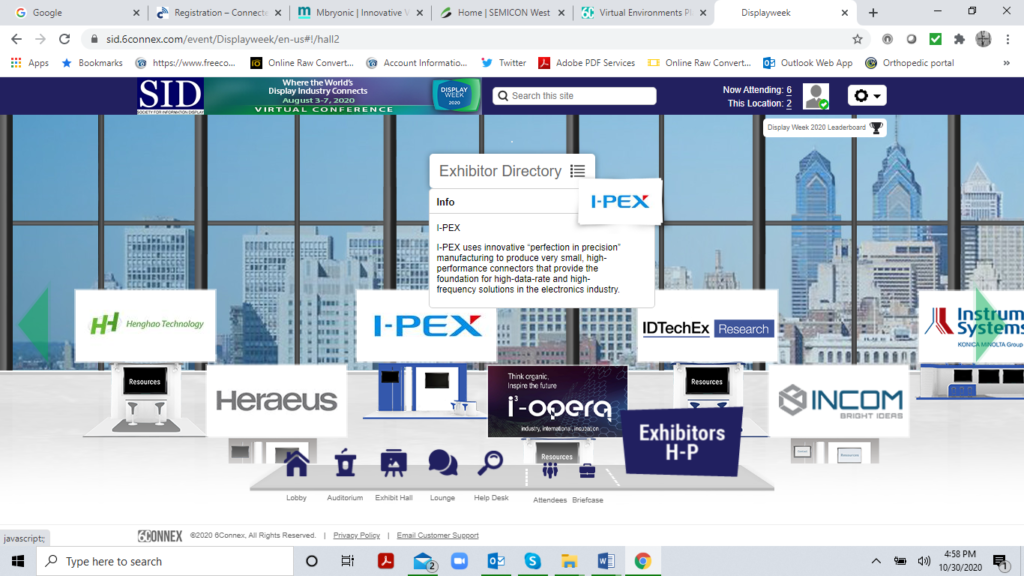 Display Week Exhibits.
Display Week Exhibits.
While both virtual events had the same elements, speakers, exhibitors, chat rooms, downloadable materials and a scavenger hunt-type challenge with daily prizes, for me the Display Week user interface was simpler to use and its use of larger people in the images worked for me. I know that may seem odd as we know all the images are NOT real people. But having them appear a bit larger than what SEMI had used made it a bit more real and relatable for me. The larger images reminded me of similar environments that I found myself in when I attended physical events. See below Display Week’s Chat Room for a sample of what I am referring to.
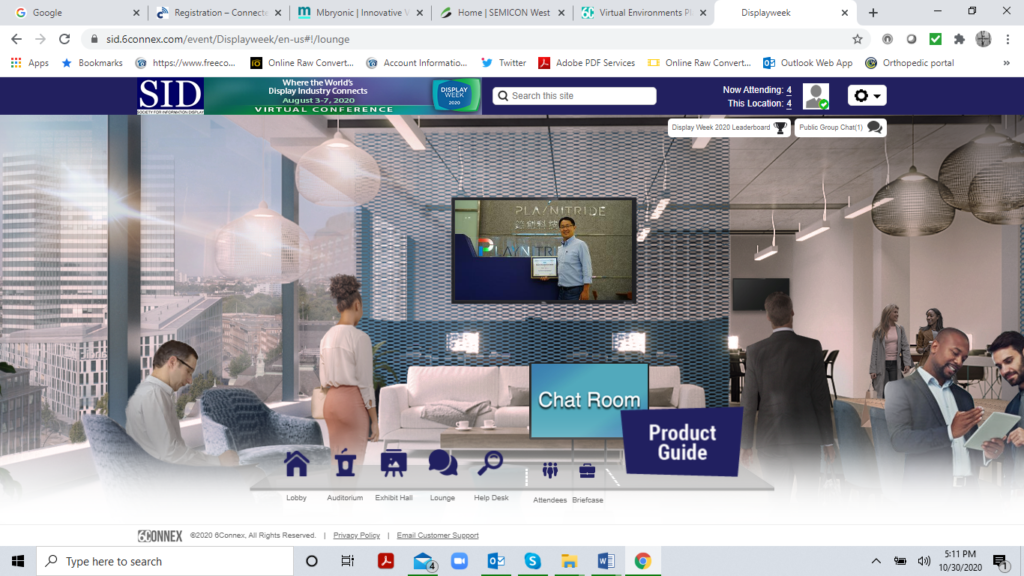
Display Week Chat Room.
What have we learned from this mini comparison? All virtual events are not alike and good navigation is the key to happy attendees. Also (in my case at least), the use of larger images of real people helps to make the experience closer to what we are used to at physical events. For physical events, attendees don’t just consume content, but they participate in it, interact with it and share it with others. The closer we can enable virtual events to do the same, the more success companies in the virtual environment will have. That leads me to what may be next for virtual platforms.
What’s Next for Virtual Events?
Many believe that once AR/VR becomes more sophisticated and widely adopted, it will become the basis for virtual event platforms in the future. However, the technology is not quite there yet, nor retooled for a virtual tradeshow or conference. That said, mbryonic has some great ways to use AR/VR for product demos once we are all back on the trade show floor. I think the company’s use of Microsoft HoloLens to fit a jet liner in a trade show booth is worth a look. Check out the video here. But again, it will be some time in the future when we can use AR/VR for a virtual tradeshow or conference platform.
With every new virtual platform, there is an inherent risk that the organizers are taking. And with the platforms still evolving, it is not an easy decision. One group looking to change the virtual experience by using a new platform is Connected. The Connected Virtual Tech Event is November 16-17, 2020.
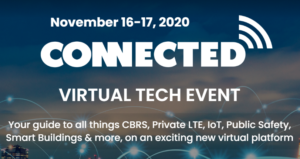 This virtual event is for real estate leaders, public safety officials, municipal government officials, wireless providers, healthcare providers, hospital administrators, hotel operators and more.
This virtual event is for real estate leaders, public safety officials, municipal government officials, wireless providers, healthcare providers, hospital administrators, hotel operators and more.
Connected says, “We will be using a new, totally different platform based on gaming technology that will change the entire virtual experience. On this new platform, you will have the closest experience to a live trade show, possible, where you can see friends, clients, or prospects and interact with them, on the spot. This is unique among virtual platforms and adds an entirely new dimension to trade shows. We expect this to become the future of virtual events.”
Check out the Connected Virtual Event Demo Video. I have registered and plan to base my next blog on my experience and feedback on the Connected Virtual Event. If you want to attend the event because the topic is in your area of expertise or you’re just curious about the new platform, you can register here.
While we are still working in the virtual environment, we will see other ideas and formats come to the surface to continue to make events more successful. Once the world is able to get back to physical events, I believe we will see a hybrid approach to future events. These will take the positives of both virtual and physical events and blend them together to create the next era of events. We’re on an interesting ride moving from ‘Couch Conferences’ to the next event innovations!
